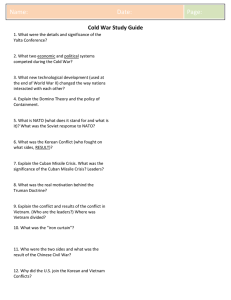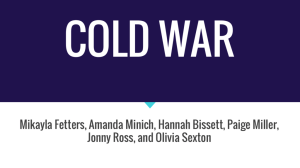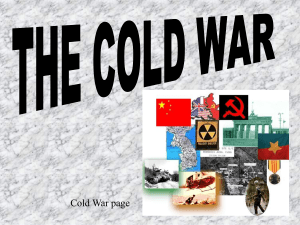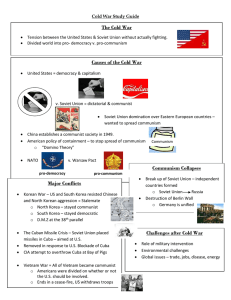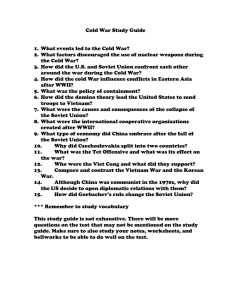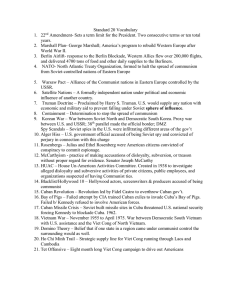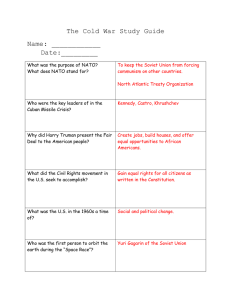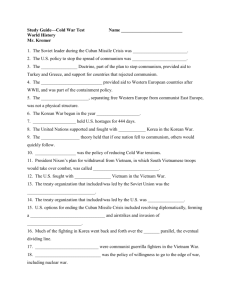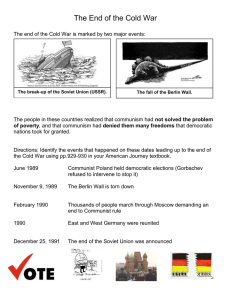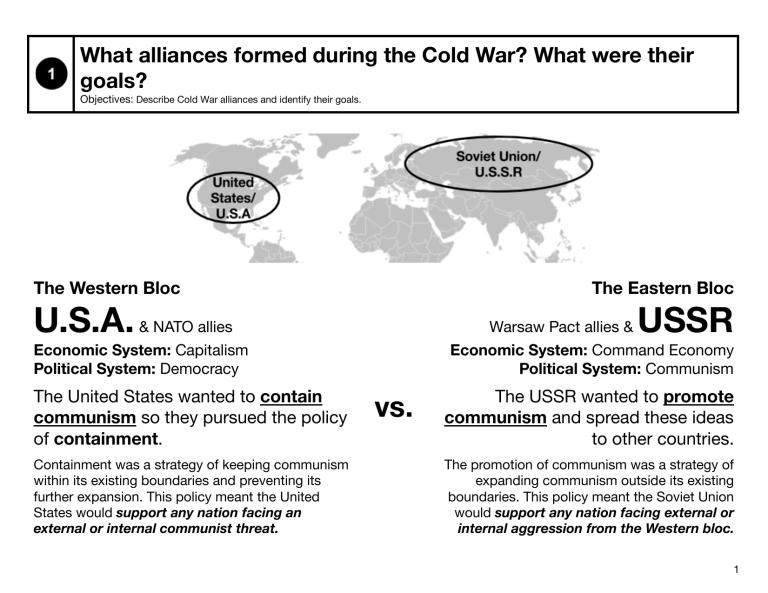
What alliances formed during the Cold War? What were their goals? Objectives: Describe Cold War alliances and identify their goals. The Western Bloc The Eastern Bloc U.S.A. & NATO allies Warsaw Pact allies & Economic System: Capitalism Political System: Democracy The United States wanted to contain communism so they pursued the policy of containment. Containment was a strategy of keeping communism within its existing boundaries and preventing its further expansion. This policy meant the United States would support any nation facing an external or internal communist threat. USSR Economic System: Command Economy Political System: Communism vs. The USSR wanted to promote communism and spread these ideas to other countries. The promotion of communism was a strategy of expanding communism outside its existing boundaries. This policy meant the Soviet Union would support any nation facing external or internal aggression from the Western bloc. 1 How did the Soviet Union seek to expand communism during the Cold War? How did the United States try to contain it? Objectives: Describe e偒orts and outcomes of attempts to expand and contain communism in Korea, Cuba, Vietnam, and Afghanistan Cold War Hot Spots The Cold War emerged as a series as wars and con牖icts between the United States (and their NATO allies) and the Soviet Union (and their Warsaw Pact allies). Even though the Cold War began in Europe, it spread around the world. Below, are examples of four Cold War con牖icts. 2 Korean War: 1950-1953 Directions: Read the excerpt below and respond to the questions. The Korean War is the name given to a civil war between the nations of North Korea and South Korea, which were created out of the occupation zones of the Soviet Union and United States established at the end of World War II. The con牖ict began on June 25, 1950, and 됣ghting continued until an armistice on July 27, 1953, although, since no o磱�cial peace treaty was signed, the war is still not technically over. The Soviet Union and People's Republic of China, seeking to expand the communist sphere of in牖uence, aided the North Koreans, while forces representing the United Nations—led primarily by the United States with troops provided by 15 other nations, aided the South Koreans. The Korean War pitted American and Soviet hardware against each other without the threat of all-out nuclear strikes (although limited nuclear strikes were discussed once the Chinese became involved). Each side wanted to unite the Korean peninsula under its own political ideology. Finally, after massive swings in favor of both the North and the South, at the end of the con牖ict, Korea remained divided along the 38th parallel. The demilitarized zone (DMZ) between the two nations is still the most heavily forti됣ed border in the world. There is a constant hope among the populations in both North and South that Korea will again be united under one 牖ag. Map of Korea Today Photograph of US Marines 됣ghting to help the South Koreans watching bombs explode on Chinese troops who assisted North Korean troops in December, 1950. Source: https://en.wikipedia.org/wiki/File:Koreacloseairsupport1950.JPEG Source: https://commons.wikimedia.org/wiki/File:Map_korea_without_la bels.png Source: http://www.newworldencyclopedia.org/entry/Korean_War 3 1. What did the U.S. and its allies want 2. What did the Soviet Union and its during the Korean War? How did they try allies want during the Korean War? How to meet their goals? did they try to meet their goals? The United States and its allies supported: The Soviet Union and its allies supported: (Circle One) (Circle One) South Korea North Korea South Korea 3. How did the Korean War impact Korea? North Korea 4. As a result of the Korean War, was communism contained or expanded? Explain. 4 Vietnam War: 1954-1975 Directions: Read the excerpt below and respond to the questions. Why did this con牖ict begin? The Vietnam War was a long and expensive war between the communist regime of North Vietnam and Viet Cong (communist-led guerrillas) and the anti-Communist South Vietnam and its ally, the United States. The communist regime of the north wanted to unify Vietnam into a single state that would be based on communist ideology. In 1958, the Viet Cong began to battle the South Vietnamese government. Motivated by a policy of containment, the United States pledged support for the anti-communist South Vietnam. The United States and its allies provided training and equipment from the American military. The United States also deployed large numbers of military personnel to South Vietnam. Later in the war, the United States launched airstrikes and committed more foot soldiers. A Viet Cong prisoner captured in 1967 by the U.S. Army awaits interrogation. He has been placed in a stress position by tying a board between his arms. Source: https://en.wikipedia.org/wiki/Vietnam_War#/media/File:Vietconginterrogation1967.jpg From 1968 to 1973, e偒orts were made to end the con牖ict through diplomacy or dialogue. By January 1973, an agreement was reached and the United States forces were withdrawn from Vietnam and United States prisoners of war were released. In 1975, South Vietnam surrendered to the North. Vietnam was uni됣ed as a communist state called the Socialist Republic of Vietnam. The Vietnam War had disastrous e偒ects. Vietnam’s infrastructure was destroyed and farmland was polluted by American chemical warfare (Agent Orange). An estimated 2 million Vietnamese died and another 3 million were wounded. About 12 million became refugees who 牖ed to neighboring countries. During the Vietnam War, 58,000 Americans died in Vietnam and the war cost the United States millions of dollars. The United States entrance into the war led to protests by students and others at home in the United States. Despite all the money and troops the United States sacri됣ced, it failed to "contain" communism. Finally, by 1973, Nixon announced that America was abandoning the Truman Doctrine, or the doctrine that the United States would provide political, military and economic assistance to all democratic nations under threat from external or internal Communist forces. Sources: http://www.history.com/topics/vietnam-war/vietnam-war-history, http://www.newworldencyclopedia.org/entry/Vietnam_War, http://www.bbc.co.uk/schools/gcsebitesize/history/mwh/vietnam/afterthewarrev1.shtml 5 1. What did the U.S. and its allies want during the Vietnam War? How did they try to meet their goals? 2. What did the Soviet Union and its allies want during the Vietnam War? How did they try to meet their goals? The United States and its allies supported: The Soviet Union and its allies supported: (Circle One) (Circle One) South Vietnam North Vietnam & Viet Cong South Vietnam 3. How did the Vietnam War impact the United States and Vietnam? North Vietnam & Viet Cong 4. As a result of the Vietnam War, was communism contained or expanded? Explain. 6 Cuban Missile Crisis: 1962 Directions: Read the excerpt below and respond to the questions. Why did this con牖ict begin? In 1959, Fidel Castro led Cuba in what became known as the Cuban Revolution. Fidel Castro sought the help of the Soviet Union to create a communist nation. With Cuba only 90 miles away from the Florida, the United States feared having a communist nation so close. An aerial view showing the medium range ballistic missile 됣eld launch in Cuba Source: https://en.wikipedia.org/wiki/File:Cubacrisis_17_Oct_1962.jpg A map showing the range of missiles 됣red from Cuba Source: http://www.bbc.co.uk/schools/gcsebitesize/history/mwh/ir2/causesofthecubacrisisrev1.shtml The United States felt threatened by Cuba’s proximity and in the spirit of containment wanted to bring down the communist regime. In 1961, President John F. Kennedy supported The Bay of Pigs Invasion, an attempt by U.S. trained Cuban exiles to overthrow Fidel Castro. The Bay of Pigs was unsuccessful and Fidel Castro captured the invaders. Shortly thereafter, the United States imposed a trade embargo, or ban on trade, with Cuba. The United States was embarrassed by its failure at The Bay of Pigs and still felt threatened by the proximity of a Soviet-backed communist country. Following the Bay of Pigs, Castro asked for weapons from the Soviet Union to defend Cuba against America. In October 1962, the United States discovered missile sites in Cuba. Most alarming for the United States was that these sites brought every town in the US within range of these nuclear missiles. This was the beginning of the Cuban Missile Crisis, a confrontation between the Soviet Union and the United States regarding the Soviet deployment of nuclear missiles in Cuba. The United States demanded that the Soviet Union remove the missiles and threatened military force. After thirteen days of tense fear of nuclear war, Soviet Premier Nikita Khrushchev removed the missiles in exchange for the United States promising not to invade Cuba. Sources: http://www.bbc.co.uk/schools/gcsebitesize/history/mwh/ir2/causesofthecubacrisisrev1.shtml, http://www.history.com/topics/cold-war/cuban-missile-crisis, http://www.newworldencyclopedia.org/entry/Cuban_Missile_Crisis 7 1. What did the U.S. want during the Cuban Missile Crisis? How did they try to meet their goals? 2. What did the Soviet Union want during the Cuban Missile Crisis? How did they try to meet their goals? 3. Why was the United States deeply invested in this Cold War Crisis? 4. As a result of the Cuban Missile Crisis, was communism contained or expanded? Explain. Explore Multiple Perspectives on the Cuban Missile Crisis Stanford History Education Project: The Cuban Missile Crisis of October 1962 pushed the United States and the Soviet Union to the brink of nuclear war. In this lesson, you can examine letters between President Kennedy and Soviet Chairman Kruschev and a cable from Russian Ambassador Dobrynin to address the question: Why did the Russians pull their missiles out of Cuba? https://sheg.stanford.edu/cuban-missile-crisis 8 Soviet-Afghan War: 1979-1989 Directions: Read the excerpt below and respond to the questions. Why did this con牖ict begin? A mujahideen, a captain in the Afghan army Source: http://www.theatlantic.com/photo/2014/08/the-soviet-war-in-afghanistan-1979-1989/100786/ In April 1978, Afghanistan’s government was overthrown by military o磱�cers who supported communism. The new government forged close relationships with the Soviet Union, but was greatly disliked by the devout Muslim and largely anticommunist population. Insurgencies [rebellions] rose against the new communist government. The insurgents or rebels were known as the mujahideen. There was internal 됣ghting and coups that threatened the stability of the new communist government. In December 1979, the Soviet Union invaded Afghanistan to protect the communist government. Nearly 100,000 Soviet soldiers took control of major cities in Afghanistan. The mujahideen quickly resisted and the Soviet forces attempted to destroy the insurgents. They bombed and depopulated civilian areas where the mujahideen and its supporters were located. The Soviet strategies to subdue the mujahideen led to mass migration from the countryside into neighboring countries. Millions of Afghan people 牖ed to Pakistan and Iran. Motivated by a policy of containment, the United States and its European allies supported the mujahideen against the Soviets. The United States provided aid to the the Afghan people. The United States and allies also provided weapons, military training, and funding to the mujahideen. The mujahideen were able to 됣ght back against the Soviet forces using shoulder-됣red antiaircraft missiles supplied by the United States. Soviet troops on the move in Afghanistan, mid-1980s Source: http://www.theatlantic.com/photo/2014/08/the-soviet-war-in-afghanistan-1979-1989/100786/ The toll in Soviet casualties, economic resources, and loss of political support of Soviet leaders at home forced the Soviet Union to consider an exit strategy. By 1988, the Soviet Union signed an accord with the United States, Pakistan, and Afghanistan and agreed to withdraw its troops. By Feb. 15, 1989, Afghanistan returned to nonaligned status. Sources: http://www.britannica.com/event/Soviet-invasion-of-Afghanistan, http://www.newworldencyclopedia.org/entry/Soviet-Afghan_War https://history.state.gov/milestones/1977-1980/soviet-invasion-afghanistan 9 1. What did the U.S. and its allies want during the Soviet-Afghan War? How did they try to meet their goals? 2. What did the Soviet Union and its allies want during the Soviet-Afghan War? How did they try to meet their goals? The United States and its allies supported: The Soviet Union and its allies supported: (Circle One) (Circle One) Mujahideen Communist Government Mujahideen 3. How did the Soviet-Afghan War impact the Soviet Union, United States and Afghanistan? Communist Government 4. As a result of the Soviet-Afghan War, was communism contained or expanded? Explain. 10 Regents Multiple Choice Check for Understanding 1. Which title best completes the partial outline below? I. ___________________________ A. Berlin blockade B. Cuban Missile Crisis C. Vietnam War (1) Path to World War I (2) Victories for Democracy (3) Cold War Confrontations (4) Terrorism in the 20th Century 2. United States involvement in the Vietnam War and the Soviet Union's involvement in Afghanistan were motivated mainly by a desire to (1) exploit the mineral resources of the regions (2) support governments that would remain strong allies (3) stop the expansion of Japan into the Middle East (4) establish independent nation-states in the regions 3. One reason for both the French Revolution (1789) and the Cuban Revolution (1959) was that (1) people often rebel when they are governed by a foreign power (2) the monarchs did not meet the needs of culturally diverse populations (3) the writings of Karl Marx encouraged workers and the industrialists to unite (4) existing governments failed to address the major economic di偒erences between social classes 4. The Berlin Blockade in 1948, the Hungarian Revolt of 1956, and the invasion of Afghanistan in 1979 all demonstrated that the Soviet Union (1) wanted to join the North Atlantic Treaty Organization (NATO) (2) used economic sanctions to achieve its foreign policy goals (3) was willing to use military force in situations that challenged its power (4) hoped to advance its economy through cultural exchange 5. Which statement would be consistent with the views of Fidel Castro? (1) The spread of Communism is the greatest danger facing Latin America. (2) An American military presence is the key to the defense of Latin America. (3) Progress and justice in Latin America can be achieved only through revolutionary Socialism. (4) Introducing a free-market system will improve the economies of Latin American nations. 6. The Truman Doctrine, Korean War, crisis in Guatemala, and Soviet invasion of Afghanistan were all (1) reasons for the Industrial Revolution (2) examples of Japanese imperialism (3) events of the Cold War (4) causes of World War II 7. The 38th parallel in Korea and the 17th parallel in Vietnam were used to mark (1) boundaries created by mountain ranges (2) demarcation lines instituted by papal authority (3) territorial claims disputed between ethnic minorities (4) political divisions established between communist and noncommunist territories 11
